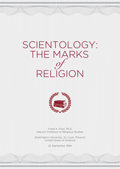There is no hard-and-fast definition of worship which can be applied to all forms of religion with complete impartiality. At the end of section II above, on the marks of religion, I noted that every religion will have all three marks (a system of beliefs, religious practices, and religious community) in some way, but no two religions will have them in the precise same degree or in the same manner. These variations are what make religions unique. Roman Catholicism, Eastern Orthodoxy, and high Anglicanism place an enormous stress on elaborate rituals, including vestments, processions, candles, hymns, icons, holy water, incense, and so forth. On the other hand, in many strict Protestant denominations such as the Brethren, such ornate ceremonial forms are considered slightly superstitious if not outrightly idolatrous. In the branches of Christianity, worship is pared down to the preaching of the Word, maybe a few hymns, and prayer. Among the Religious Society of Friends—commonly known as the Quakers—the Meeting for Worship consists of no external acts at all but is a gathering in silence during which members may or may not share a brief word of inspiration. Likewise, the central act of worship in Buddhist monasteries is totally silent meditation for great periods of time centered not on revering a Supreme Deity but on the extinction of the self and release from the entanglements of existence.
The impossibility of discovering any absolutely rigid and fixed definition of worship necessitates keeping a flexible notion for comparative study. Most dictionary definitions face this problem by including several ideas under the concept of worship. First, worship can include ideas of “rites” and “ceremonies.” Some scholars of religion see rites and rituals as being transformative. In the Christian rite of baptism, for example, an initiate is transformed from one state (sin) to another (grace). In primal societies, the rites of passage transform neophytes from childhood to adulthood. The Scientology auditing process of passing from the state of “preclear” to “Clear” would be transformative in this sense. Conversely, ceremonies are seen as confirmatory; that is, they affirm and confirm the status quo. Various forms of Sabbath and Sunday services are often ceremonies in this sense. Ceremonies confirm to the believing community its status as a worshipping body and its identity as a denomination. Often, but not necessarily always, accoutrements including vestments, rites and ceremonies are accompanied by elaborate dancing, music, sacred sprinklings and purifications, sacrifices of animals or food, gestures such as blessings, and so forth.
Secondly, scholars of religion universally recognize that rites and ceremonies cannot be the end-all and be-all of worship. Hence, most definitions include further notions such as “practices,” “acts” and “observances.” These further notions are included in common definitions for good reasons. One person’s worship may be another’s superstition. And what may appear to be a meaningless act to one believer—for example, making the sign of the Cross, to a Protestant—may be an act of devotion to another. Thus scholars are compelled to see religious acts in the context of the specific religion as a whole, that is, in terms of the ultimate goals and intentions of the body of believers. The scholar does not have to believe what the believer believes, but if he or she is seriously attempting to understand religious phenomena, that scholar must take a step in the direction of believing as the believer believes. It is only from this stance that the scholar can determine which acts, practices and observances constitute worship in a given religious community.
Under the broader definition of religious worship (acts, practices, observances) we can include such topics as the study of sacred texts, the training of others in the study and recitation of these texts, and various forms of religious instruction. Some religions even imbue these kinds of acts with sacred ceremony. In Japanese Zen monasteries, I have observed Zen novices ceremonially carrying copies of the Lotus Sutra and solemnly committing it to memory through ritualized chanting. The study of the Talmud in Jewish yeshivas takes on a similar ritual character.
In the many varieties of religious worship the scholar can detect two fundamental orientations: One strand of worship is more celebratory and ritual-centered; the other is more instructional and meditation-centered.
The question of whether auditing and training can be forms of worship may naturally arise in the minds of adherents of the mainline religions of the West, namely, Judaism, Christianity and Islam. In those religions, worship is chiefly, but not exclusively, centered on public celebrations, feast days, sermons, hymn singing, Sabbath or Sunday worship, and various devotions. Although one can find this form of worship plentifully represented in Eastern religion, there is a fundamental undertone in many strands of Eastern piety which places greater stress on meditation and instruction. As already noted, in Vedanta Hinduism and Zen Buddhism, worship is centered not on celebration but on meditation and the study of sutras, spiritual textbooks. In Zen this spiritual study is often accompanied by meditation on koans, short, pithy and often contradictory sayings which aid the devotee in cracking the shell of ordinary consciousness so that he or she may attain satori, sudden enlightenment.
While the discovery and codification of the technology of auditing belongs exclusively to L. Ron Hubbard, the Church of Scientology and L. Ron Hubbard himself have always recognized that Scientology has affinities with certain aspects of Hinduism and especially Buddhism. Scientology shares with both religious traditions a common belief that the central process of salvation is the passage from ignorance to enlightenment, from entanglement to freedom, and from obfuscation and confusion to clarity and light. A number of years ago I published an article on Scientology’s relation to Buddhism: Frank K. Flinn, “Scientology as Technological Buddhism” in Joseph H. Fichter, editor, Alternatives to American Mainline Churches, New York: Paragon House, 1983, pages 89–110. In consonance with these Eastern traditions, Scientology quite logically sees worship not so much in the mode of celebration and devotion but in the mode of meditation and instruction, which stresses awareness, enlightenment, or, to use the Scientology term, “Clearing.”
As an important side-note, one would not want to say that the meditational and instructional form of worship is absent in the West. The pious Orthodox Jew believes that the devout study of the Torah or Law is a form, if not the form, of worship. Hence, Orthodox Jews set up yeshivas, which are dedicated to the worshipful study of the Torah and the Talmud. A yeshiva is not simply a place for ordinary education; it is also a place of worship. Likewise, Muslims have set up kuttabs and madrassas for the devout study of the Qur’an. Similarly, many Roman Catholic monastic religious orders, most notably the Cistercians and Trappists, devote the greater part of their worship to silent study and meditation on sacred texts.
On the whole, however, meditation, sacred study and instruction are not perceived as much to be forms of worship in the West as they are in the East. In India, it is a common practice for people in later life to sell all their worldly goods, go to a sacred site, such as Varanasi (Benares) on the Ganges, and spend the rest of their lives, occasionally performing pujas or ritual offerings but mostly meditating on divine things. To the ordinary Hindu, such meditation is the highest form of worship possible.
It is abundantly clear that Scientology has both the typical forms of ceremonial and celebratory worship and its own unique form of spiritual life...
Aside from these discussions, it is abundantly clear that Scientology has both the typical forms of ceremonial and celebratory worship and its own unique form of spiritual life: auditing and training. By way of comparison and contrast, the Roman Catholic church considers all of its seven sacraments as forms of worship. That is why all the sacraments are administered principally in its churches by ordained clergy. Sacraments are administered outside church premises only under special circumstances such as ministering to the sick. The seven sacraments include baptism, confirmation, confession, reconciliation or confession, the Eucharist, marriage, holy orders and the anointing of the sick and infirm. But the “sacrament of all sacraments” for Roman Catholics is the Eucharist, commonly called the Mass, which celebrates the death and resurrection of Jesus Christ and his presence in the believing community.
So also the Church of Scientology has, so-to-speak, its “sacrament of all sacraments,” namely, auditing and training. The chief religious aim of all practicing Scientologists is to become Clear and attain the status of being an Operating Thetan who has mastery over “life, thought, matter, energy, space and time.” The central religious means to these ends are the complex levels and grades of auditing and training. What the Eucharist is in religious importance to the Roman Catholic, auditing and training is to the Scientologist. As Roman Catholics consider the seven sacraments as the chief means for the salvation of the world, so also Scientologists consider auditing and training the central means of salvation, which they describe as optimum survival on all dynamics.
As a scholar of comparative religion, I would answer the question “Where do Roman Catholics have places of worship?” with the answer “Where the seven sacraments are ministered to adherents as a matter of course.” To the question “Where do Scientologists have places of worship?” I would answer “Where auditing and training in Scientology scripture are ministered to parishioners as a matter of course.” Hubbard’s works on Dianetics and Scientology constitute the sacred scriptures of the Church of Scientology. The vast majority of these works is devoted to what Scientologists call auditing technology and the management and delivery of auditing and training to the membership. The sheer preponderance of the emphasis on auditing in Hubbard’s works will convince any scholar of religion that auditing and training are the central religious practices and chief forms of worship of the Church of Scientology.
As a scholar of comparative religion I can assert without hesitation that auditing and training are central forms of worship in the belief system of the Scientologist. Secondly, the places where auditing and training are ministered to adherents are unequivocally Scientology houses of worship.
Frank K. Flinn
22 September 1994





























